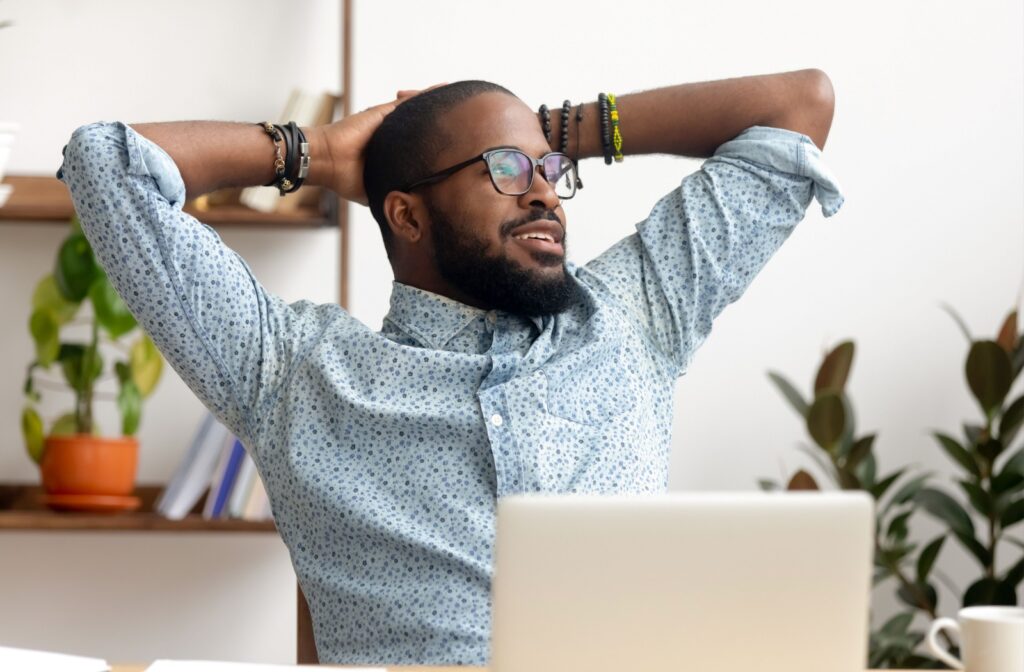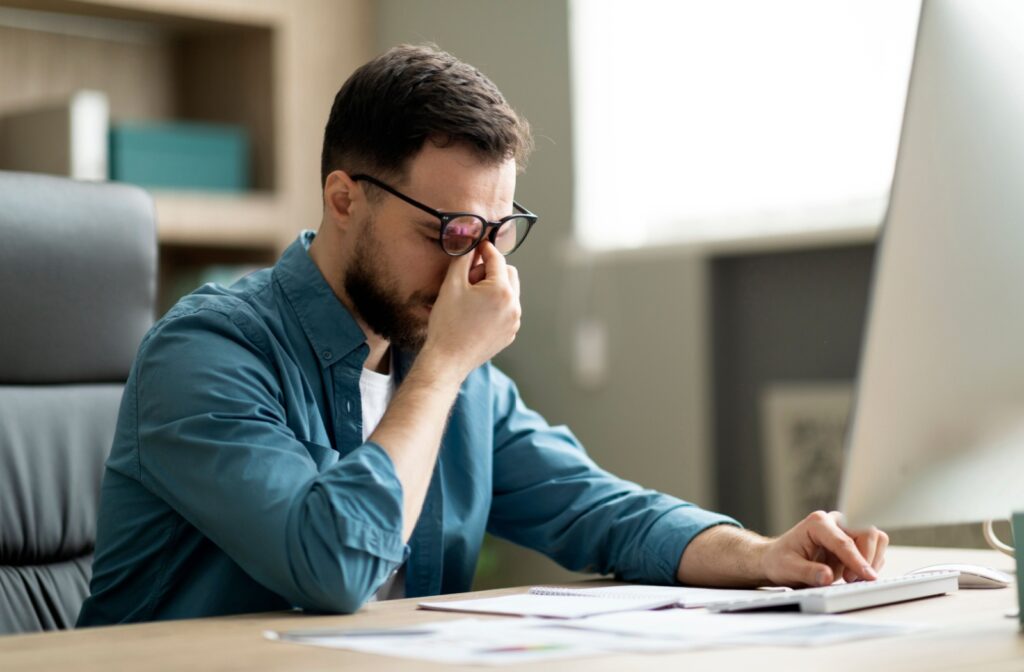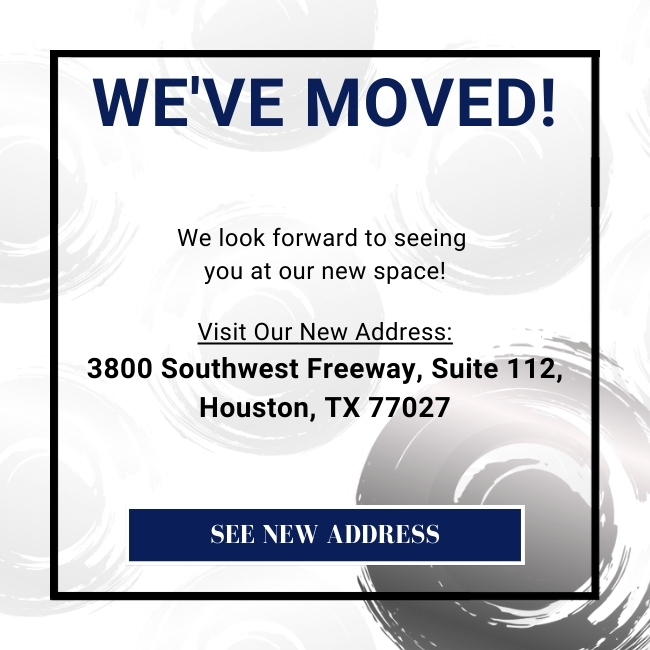Think back to the last time you stared at your screen for hours. Perhaps you were working on a report, binging your favorite series, or leveling up in a game. Regardless of what you were doing, if your eyes started to feel sore or dry, then you’ve likely experienced digital eye strain. This is the unwelcome visitor that often accompanies modern life, especially for those of us who spend a lot of time using screens.
In most cases, eye strain resolves within a couple of hours after rest, but more severe symptoms can linger into the next day if left unchecked. But you don’t have to fend for yourself. Your optometrist can assess your screen habits and help you face the digital world with open eyes.
What Is Eye Strain?
Eye strain, also known as digital eye strain or computer vision syndrome, occurs when your eyes feel tired or uncomfortable due to prolonged use or excessive focus. It’s not a disease, but rather a signal that your eyes need a break. Here’s what eye strain may look and feel like:
- Tired, sore, or dry eyes
- Blurred or double vision
- Headaches
- Increased sensitivity to light
- Difficulty focusing or concentrating
Although eye strain is typically temporary, it can make even simple tasks like reading an email or scanning a spreadsheet feel like an uphill climb. Though it can be frustrating, eye strain shouldn’t cause permanent damage when addressed properly.
The one exception is for kids. There is some evidence that children are more likely to develop vision problems due to prolonged screen time. Take care to limit your children’s screen time, encourage them to play outside, and take them in for regular eye exams.
How Long Does Eye Strain Typically Last?
Eye strain affects everyone differently. Its duration varies based on several factors, including how long your eyes were strained and what steps you choose to take to recover. For mild cases (e.g., dry or slightly uncomfortable eyes after an intense study session), relief might come within an hour or 2 once you rest your eyes.
Persistent strain caused by marathon screen sessions or poor habits may take several hours or even a full day to subside. If your symptoms are linked to an underlying issue, like uncorrected vision problems or chronic dry eye, they could persist longer without professional care.
In general, here are some factors that can affect recovery time:
- Duration of activity: Longer exposure to screens or close-up focus normally equates to longer recovery times.
- Lighting conditions: Poor lighting or excessive glare can worsen eye strain, delaying relief.
- Underlying vision issues: Uncorrected vision problems like astigmatism, hyperopia, or myopia can lengthen symptom duration.
- Screen settings: Improper contrast, brightness, or excessive blue light exposure extend the recovery phase.

Tips to Relieve & Prevent Eye Strain
Even though eye strain is temporary, there are ways to help your eyes recover faster and even prevent discomfort from creeping in again. These practical strategies are easy to implement and can make a huge difference. Here are our tips:
- Follow the 20-20-20 rule: Every 20 minutes, take a 20-second break to look at something at least 20 feet away. This gives your eyes a much-needed breather and helps them refocus.
- Optimize your screen settings: Make sure your screen brightness matches the lighting in your environment. For instance, consider using “dark mode”, especially in the evenings.
- Improve your workspace lighting: Position your screen to prevent glare from windows or overhead lights. Use task lighting and adjust natural light with curtains or blinds.
- Use eye drops for immediate relief: Artificial tears can soothe dry, irritated eyes caused by prolonged focus. Look for preservative-free options to keep your eyes moisturized throughout the day.
- Wear glasses designed for screen use: Prescription glasses with anti-glare coatings can help reduce strain. Consult your optometrist for options designed specifically for digital device use.
- Take regular breaks: If you find yourself working for hours on end, be intentional about stepping away. Go for a short walk or do something that allows your eyes to focus on distant objects.
- Blink more often: When staring at screens, we tend to blink less, leading to dryness. Make a conscious effort to blink more frequently to keep your eyes naturally lubricated.
When Should You See an Eye Care Professional?
If you notice your eye strain persists for more than a day or becomes disruptive to your daily life, it may be time to seek professional help. There may be an underlying condition contributing to your symptoms that needs attention. Common reasons to consult an optometrist include:
- Uncorrected vision problems
- Misaligned eye muscles
- Chronic dry eye syndrome
A professional eye exam can identify these issues and provide tailored solutions such as corrective lenses, specialized treatments, or lifestyle guidance.
Clear Vision For the Digital Age
Eye strain shouldn’t hold you back from excelling in your work, studies, or hobbies. Taking proactive steps to care for your eyes can help you maintain focus and comfort. If your symptoms persist or you’re ready for personalized advice, we’re here to help! At ProOptix Eye Care, we specialize in tailored care that prioritizes your eye health and comfort. Book an appointment with one of our trusted professionals today, and take the first step toward clearer, strain-free vision.





